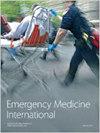The Diagnostic Evaluation of the SINEH Cardiopulmonary Triage Scale and the Emergency Severity Index in the Emergency Department: A Comparative Study
IF 0.8
4区 医学
Q3 EMERGENCY MEDICINE
引用次数: 0
Abstract
Introduction. The diagnostic evaluation of the emergency severity index (ESI) in the triage of patients with cardiopulmonary complaints has a high sensitivity but a low specificity in the emergency department (ED). Therefore, triage scales with more accurate diagnostic evaluation are required. As a result, accuracy of the SINEH triage scale (SinTS) and the ESI was compared to compare mistriage of critically ill patients with cardiopulmonary complaints. Methods. This descriptive, analytical and cross-sectional study was conducted between December 2022 and April 2023. In this study, two nurses independently examined each patient using two triage scales. The admission unit and length of hospital stay were also recorded. The outcome was classified as high-risk admission (cardiac care unit and intensive care unit) and low-risk admission (internal unit or discharge from the ED). Undertriage and overtiage were defined as high-risk admission with triage level 3 and 4 and low-risk admission with triage level 1 or 2, respectively. A panel of experts evaluated content validity of SinTS and kappa designating agreement on relevance reported. The inter-rater reliability of two scales was also reported. Results. Finally, the study included 145 patients. The average age of the patients studied was 61.35 years. SinTS has a total mistriage of 29.63%, with 4.13% being undertriage and 25.5% being overtriage. In ESI, the total mistriage is 66.8%, with 1.3% being undertriage and 65.5% being overtriage. The undertriage of the two scales did not differ significantly by admission unit (), but the overtriage of the two methods did (). The sensitivity, specificity, and accuracy of SinTS were 86.3%, 63.37%, and 72.27%, respectively, while those of ESI were 95.4%, 5.94%, and 32.79%, respectively. Conclusion. SINEH triage scale has achieved the optimal accuracy in recognizing the acuity of the patients with chest pain and dyspnea by using SpO2, pressure of end-tidal carbon dioxide, troponin I, and peak expiratory flow. When triaging patients with chest pain and dyspnea, SinTS may exhibit a higher level of accuracy compared to ESI. More research is needed to improve accuracy of triage scales in patient with cardiopulmonary complaints.急诊科 SINEH 心肺分诊量表和急诊严重程度指数的诊断评估:比较研究
简介在急诊科(ED)对心肺不适患者进行分诊时,急诊严重程度指数(ESI)的诊断评估灵敏度较高,但特异性较低。因此,需要诊断评估更准确的分诊量表。因此,我们对 SINEH 分诊量表(SinTS)和 ESI 的准确性进行了比较,以比较对有心肺不适症状的重症患者进行误诊的情况。方法。这项描述性、分析性和横断面研究在 2022 年 12 月至 2023 年 4 月期间进行。在这项研究中,两名护士使用两种分诊量表对每位患者进行独立检查。同时还记录了入院单位和住院时间。结果分为高风险入院(心脏监护室和重症监护室)和低风险入院(内部病房或急诊室出院)。分流不足和分流过度分别定义为分流级别为 3 级和 4 级的高风险入院和分流级别为 1 级或 2 级的低风险入院。专家小组对 SinTS 的内容有效性进行了评估,并对相关性的一致性进行了卡方评估。同时还报告了两个量表的评分者间可靠性。研究结果最终,研究共纳入 145 名患者。研究对象的平均年龄为 61.35 岁。SinTS 的总误诊率为 29.63%,其中 4.13% 为误诊不足,25.5% 为误诊过多。在 ESI 中,总误诊率为 66.8%,其中 1.3%为误诊不足,65.5%为误诊过多。两种量表的误诊率在入院单位上没有显著差异(),但两种方法的误诊率却有显著差异()。SinTS 的灵敏度、特异性和准确性分别为 86.3%、63.37% 和 72.27%,而 ESI 的灵敏度、特异性和准确性分别为 95.4%、5.94% 和 32.79%。结论通过使用 SpO2、潮气末二氧化碳压力、肌钙蛋白 I 和呼气流量峰值,SINEH 分诊量表在识别胸痛和呼吸困难患者的严重程度方面达到了最佳准确度。在对胸痛和呼吸困难患者进行分流时,SinTS 的准确性可能高于 ESI。要提高心肺不适患者分诊量表的准确性,还需要进行更多的研究。
本文章由计算机程序翻译,如有差异,请以英文原文为准。
求助全文
约1分钟内获得全文
求助全文
来源期刊

Emergency Medicine International
EMERGENCY MEDICINE-
CiteScore
0.10
自引率
0.00%
发文量
187
审稿时长
17 weeks
期刊介绍:
Emergency Medicine International is a peer-reviewed, Open Access journal that provides a forum for doctors, nurses, paramedics and ambulance staff. The journal publishes original research articles, review articles, and clinical studies related to prehospital care, disaster preparedness and response, acute medical and paediatric emergencies, critical care, sports medicine, wound care, and toxicology.
 求助内容:
求助内容: 应助结果提醒方式:
应助结果提醒方式:


